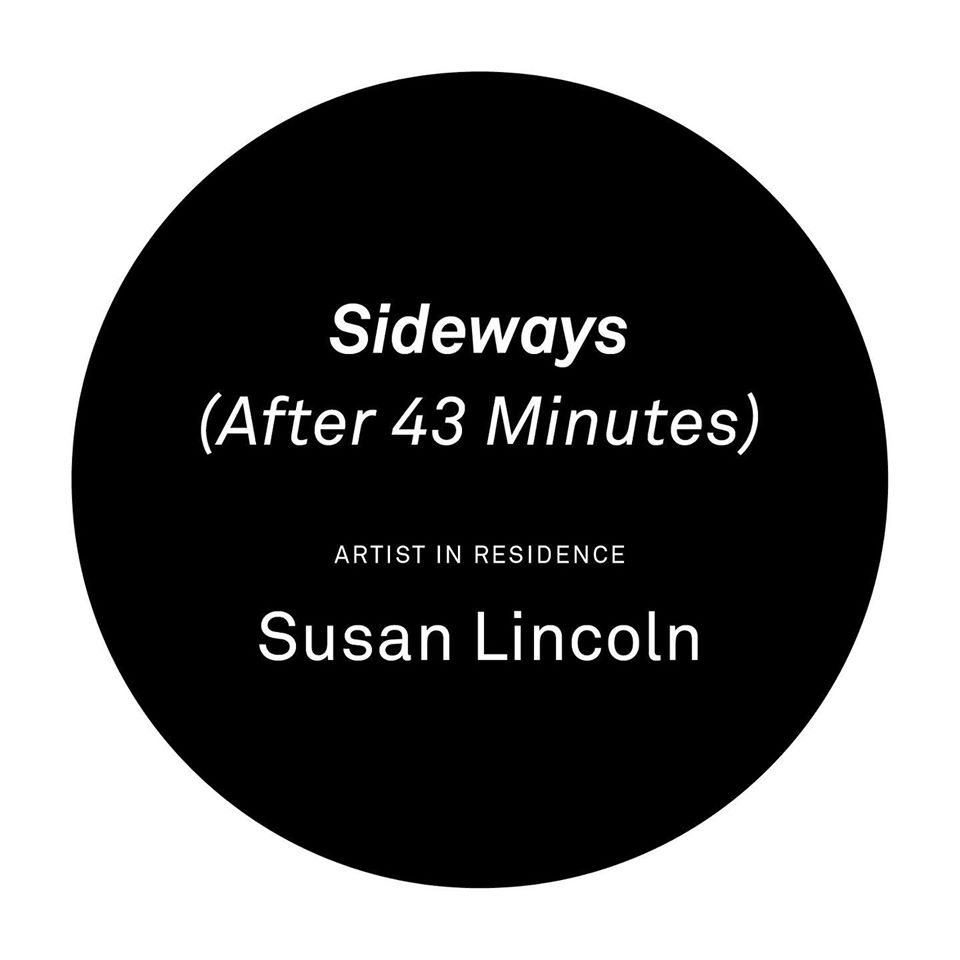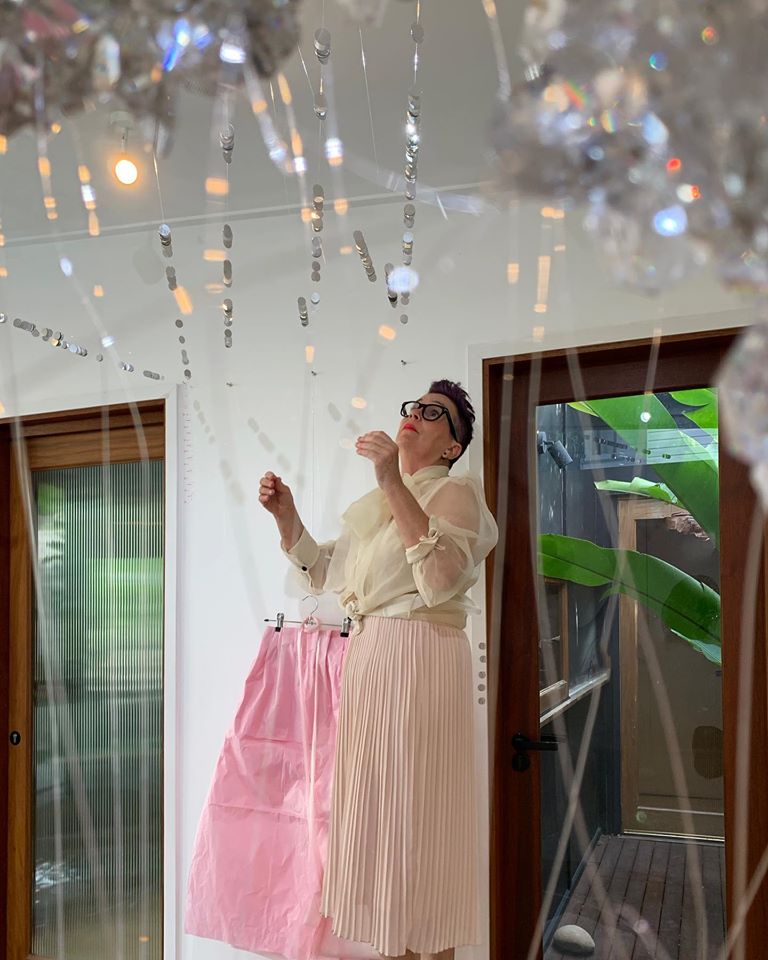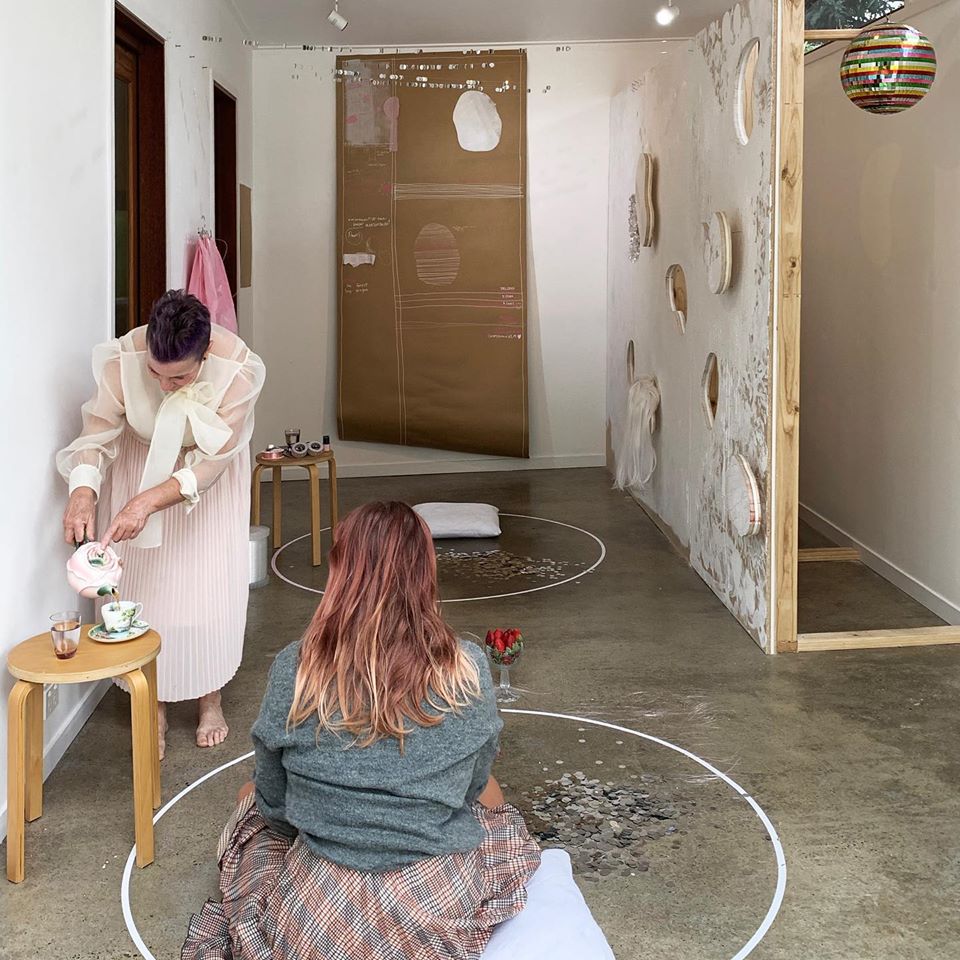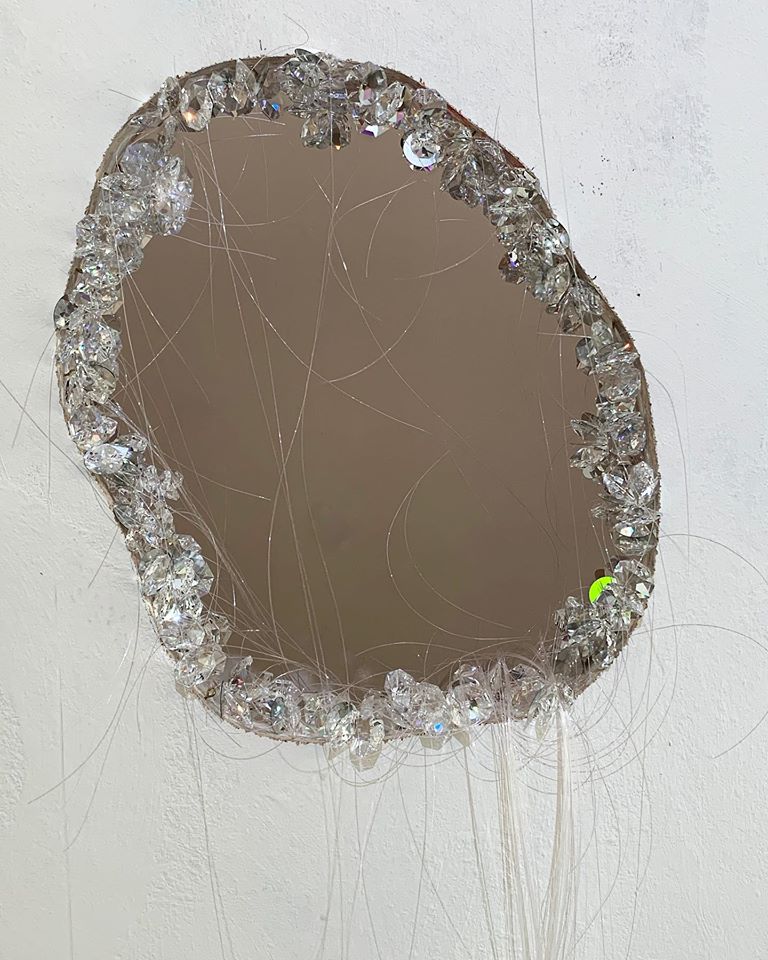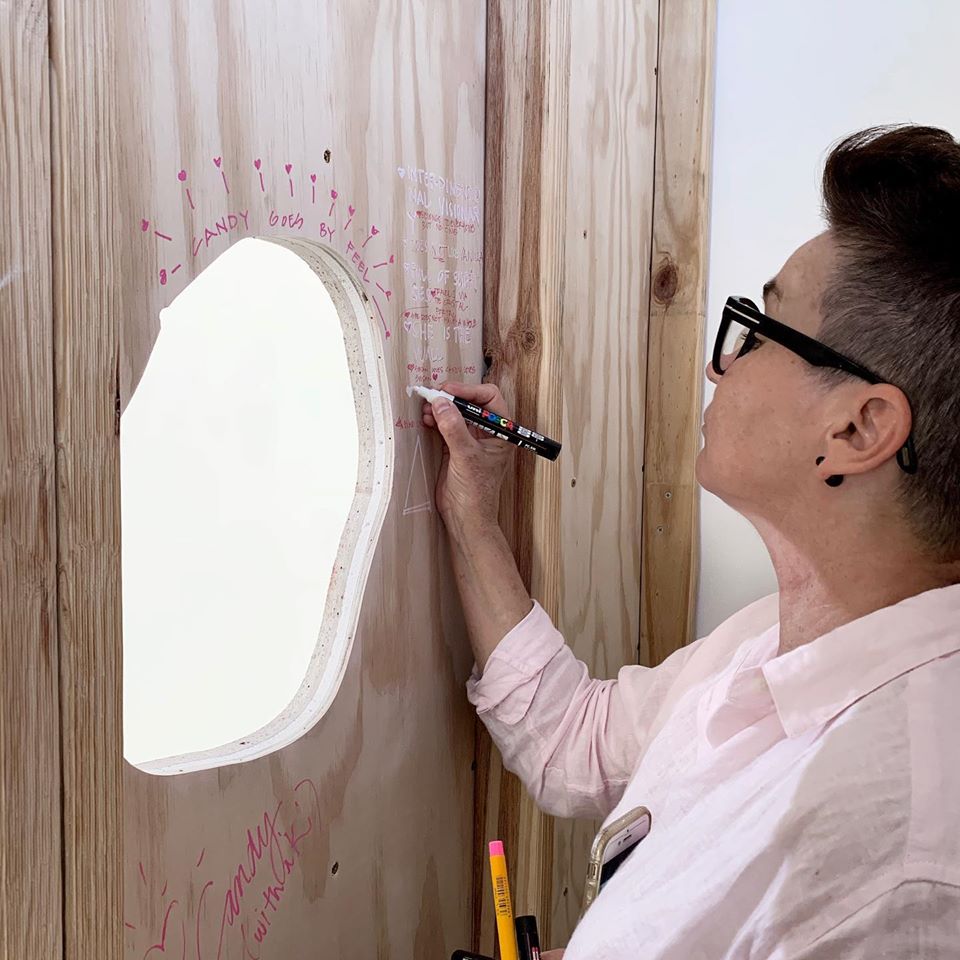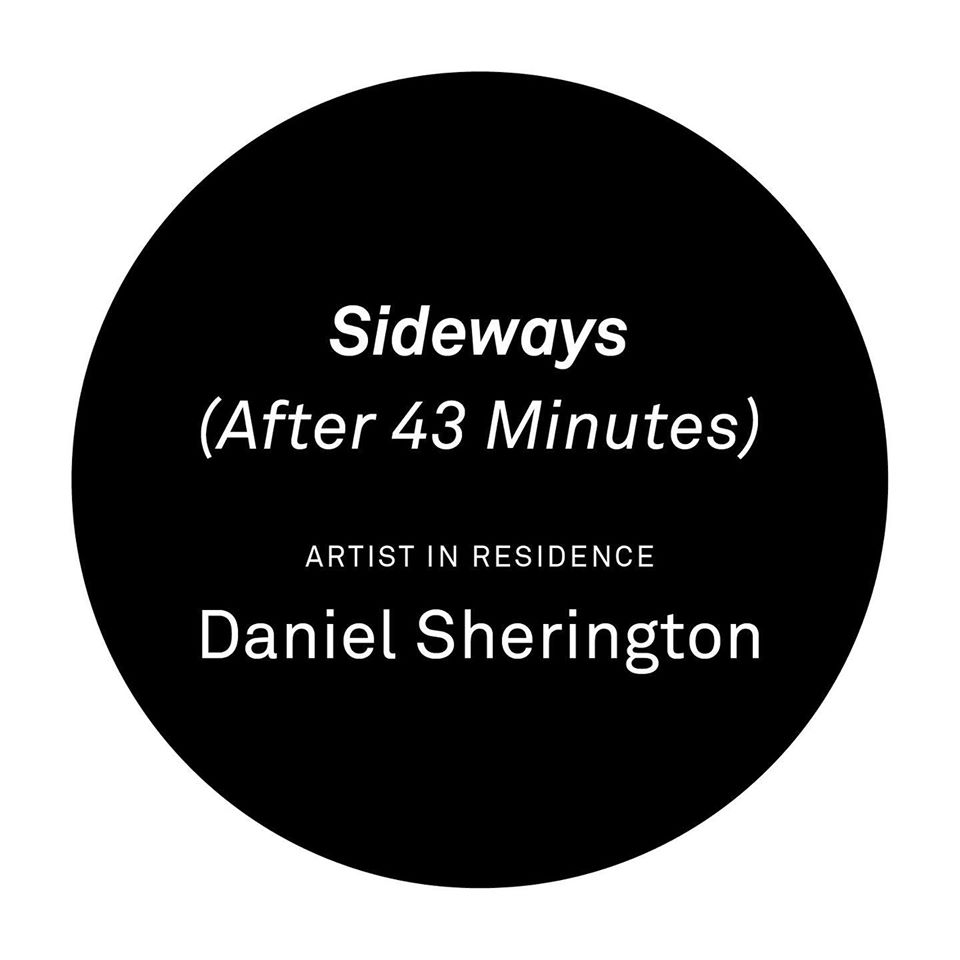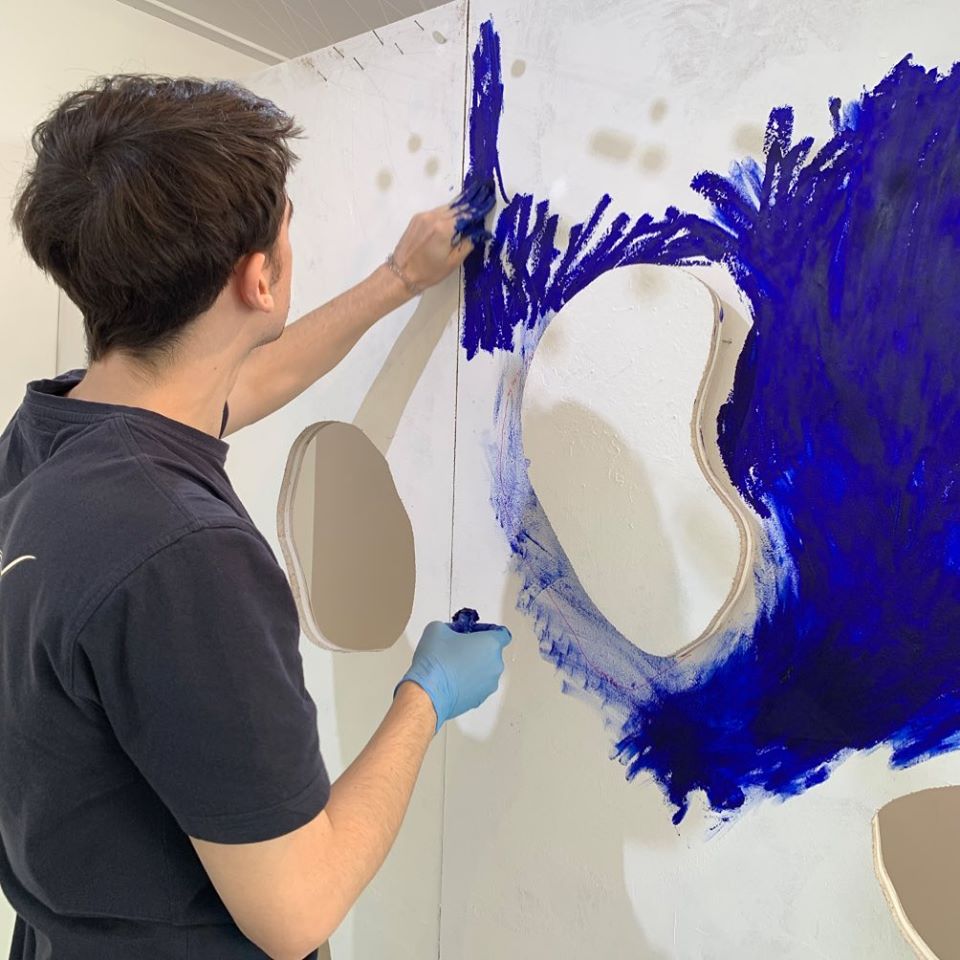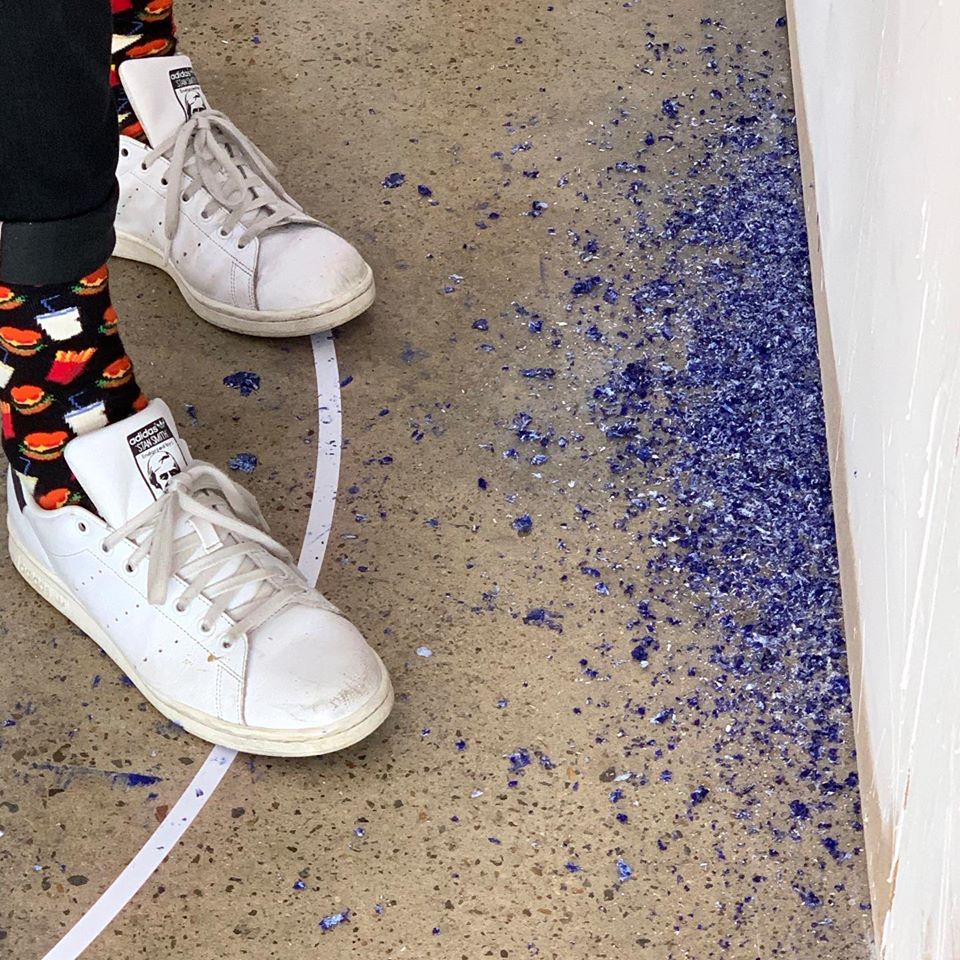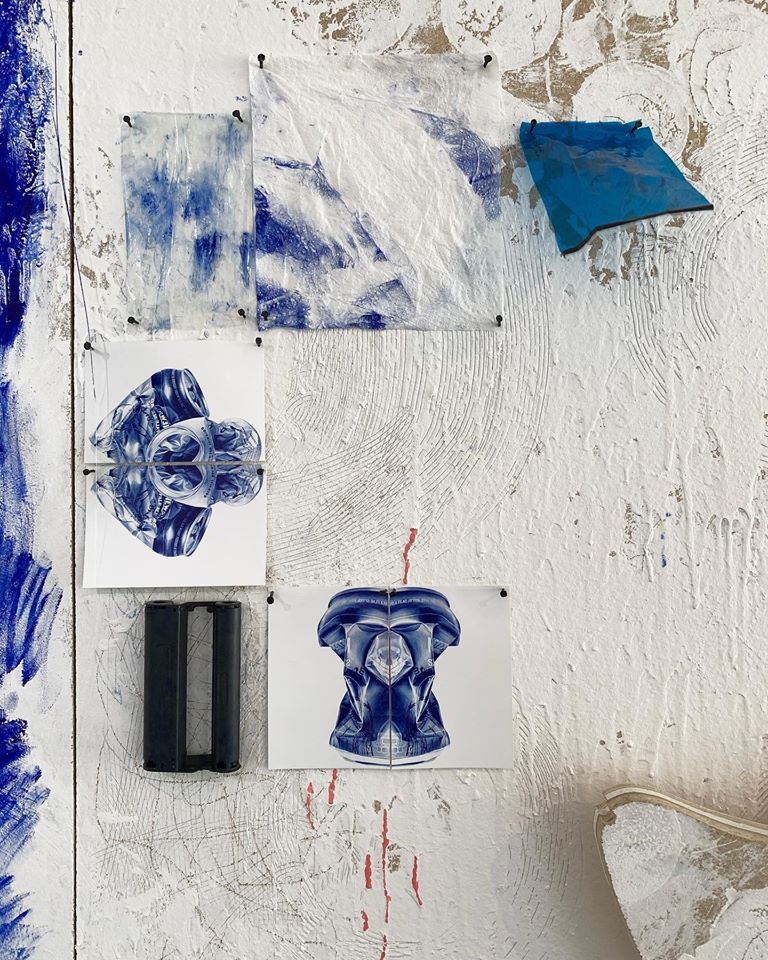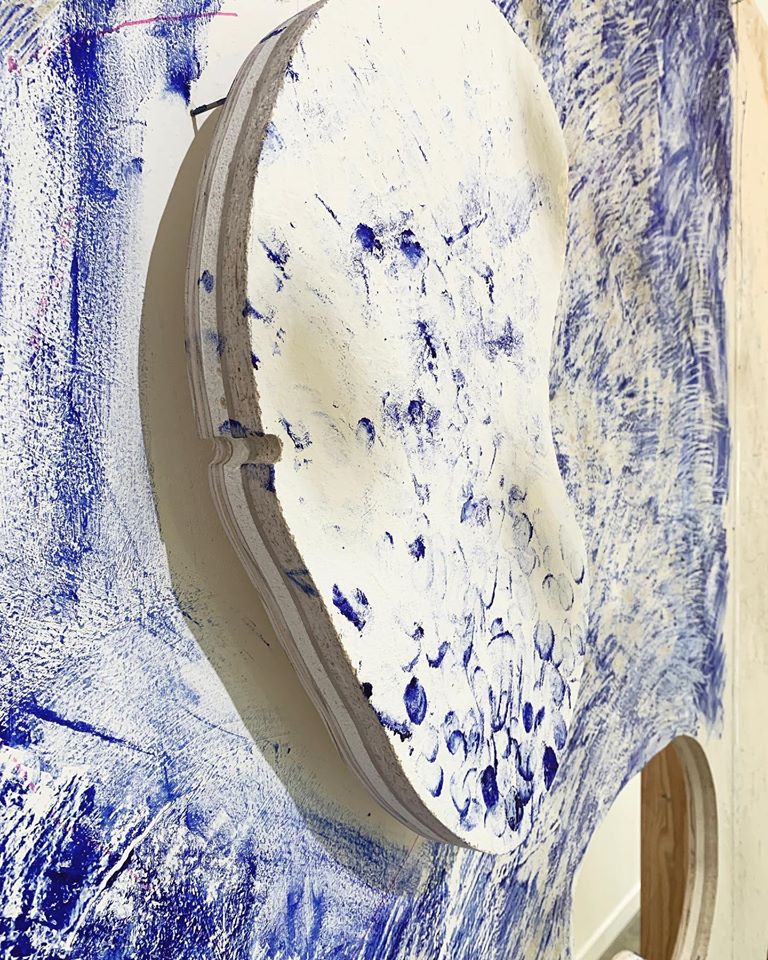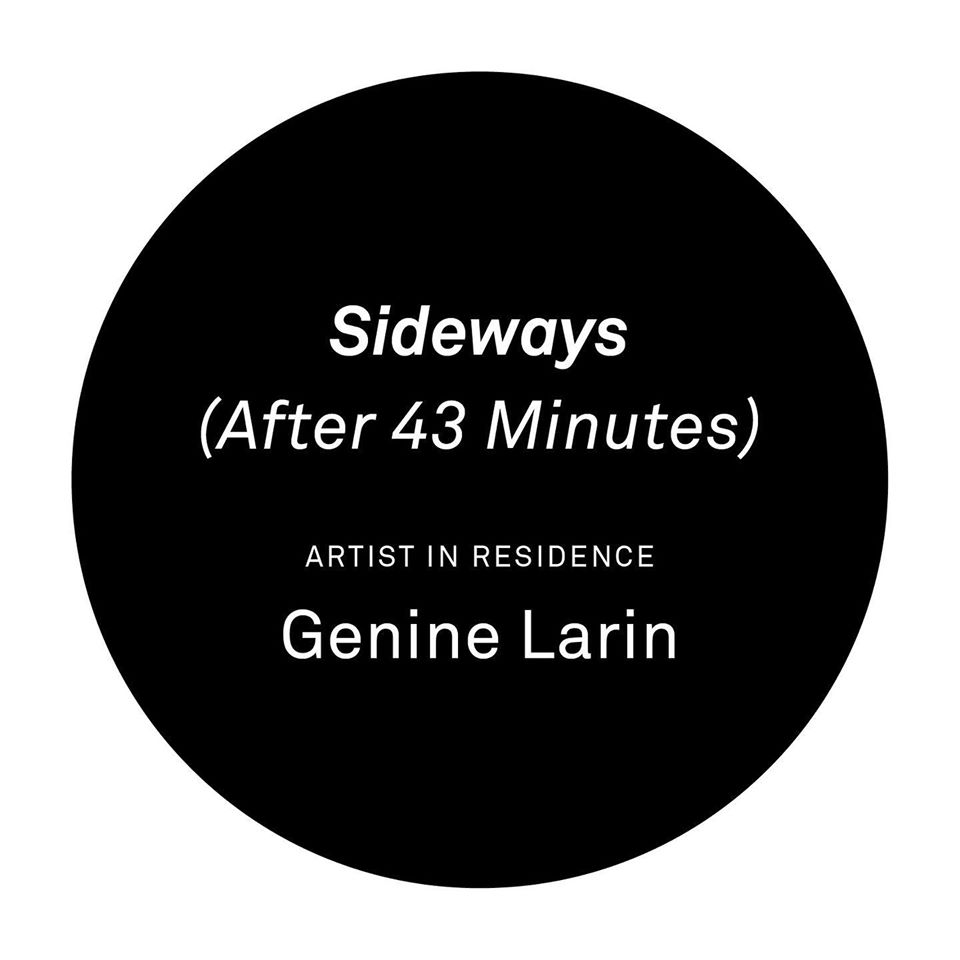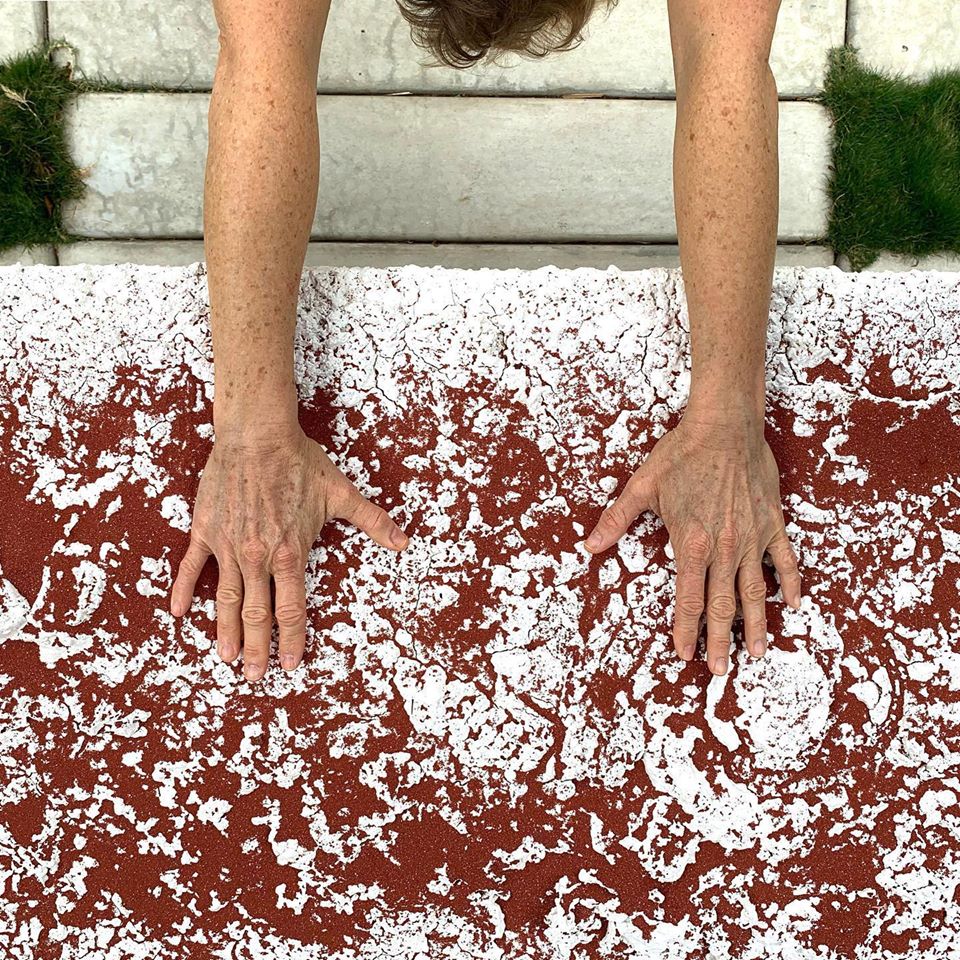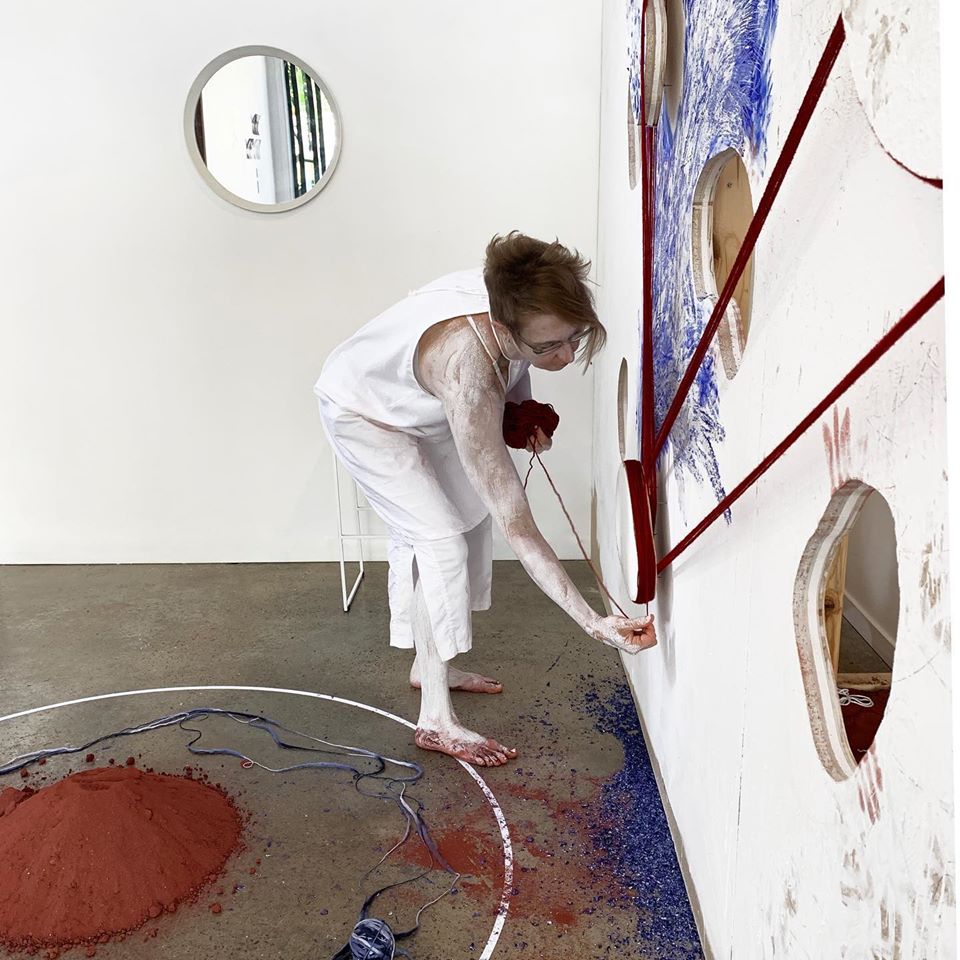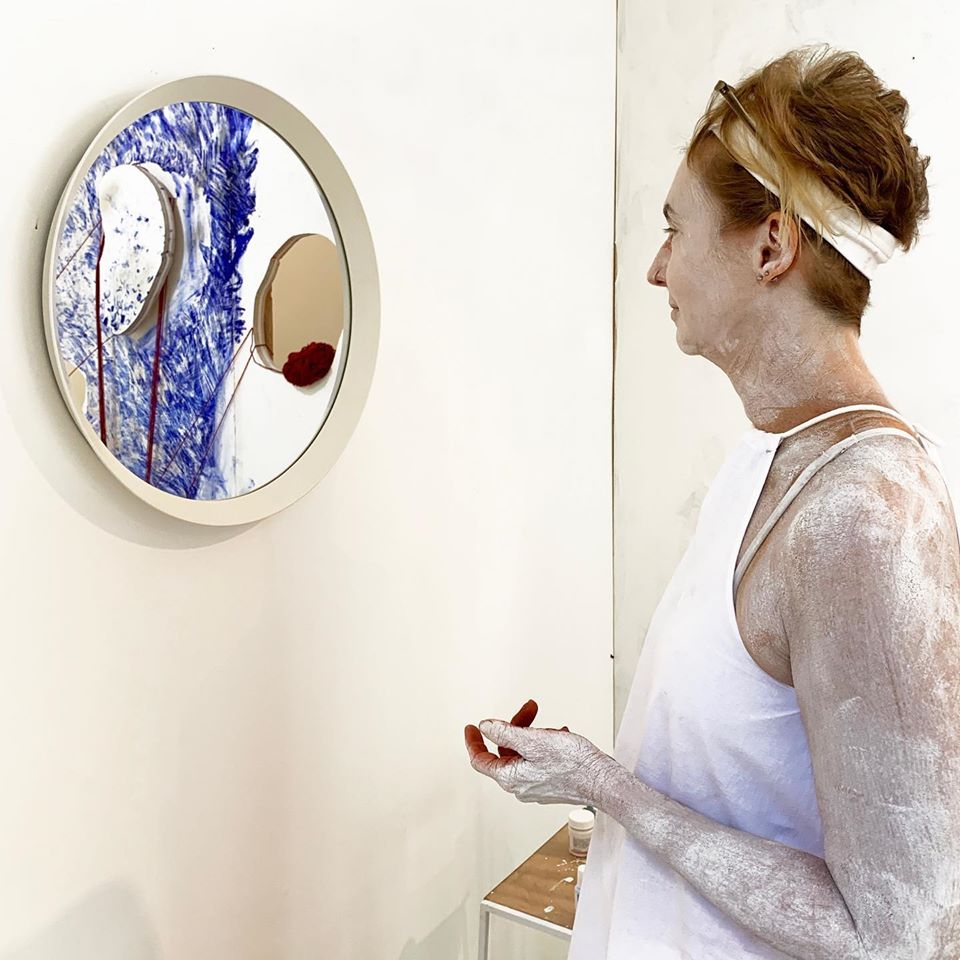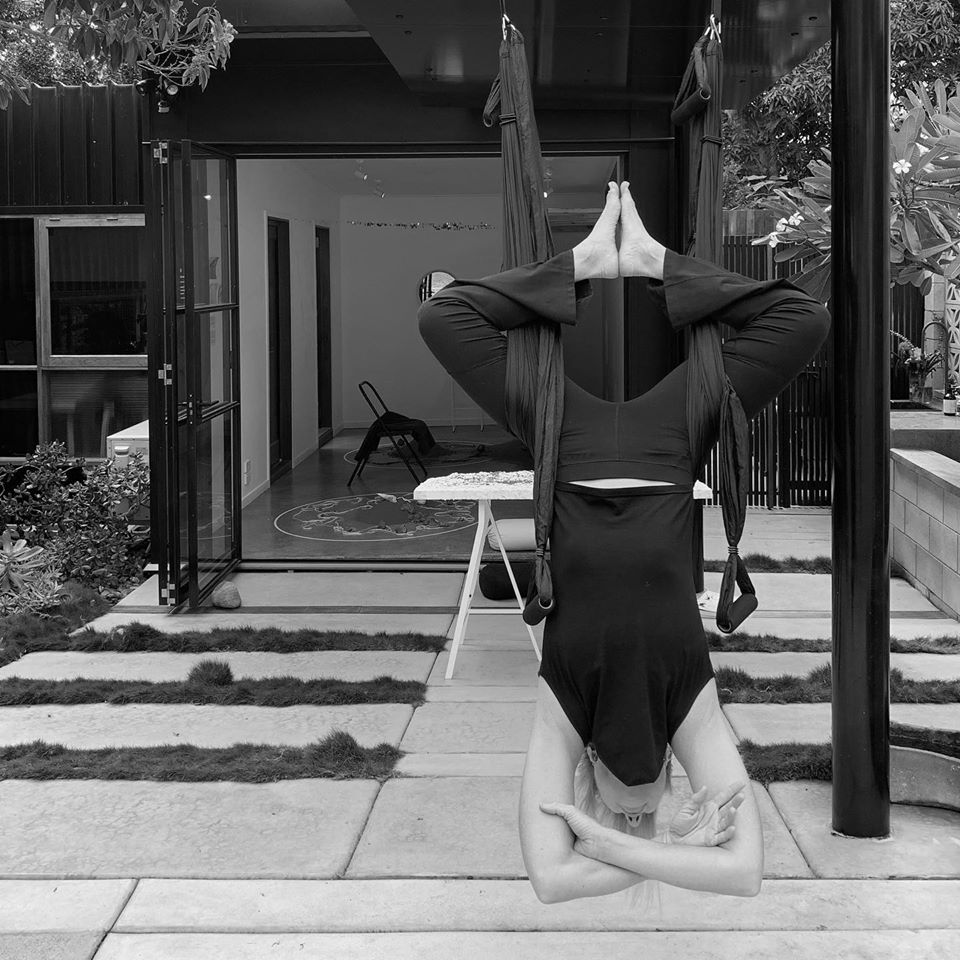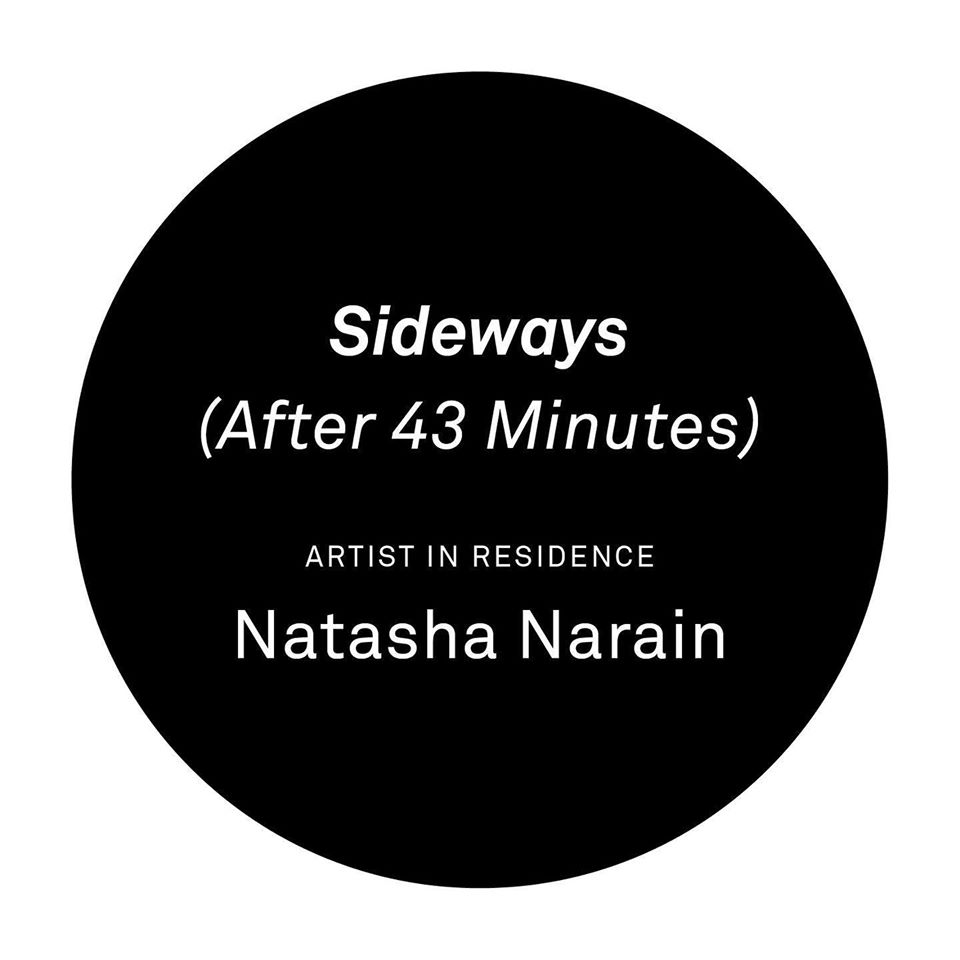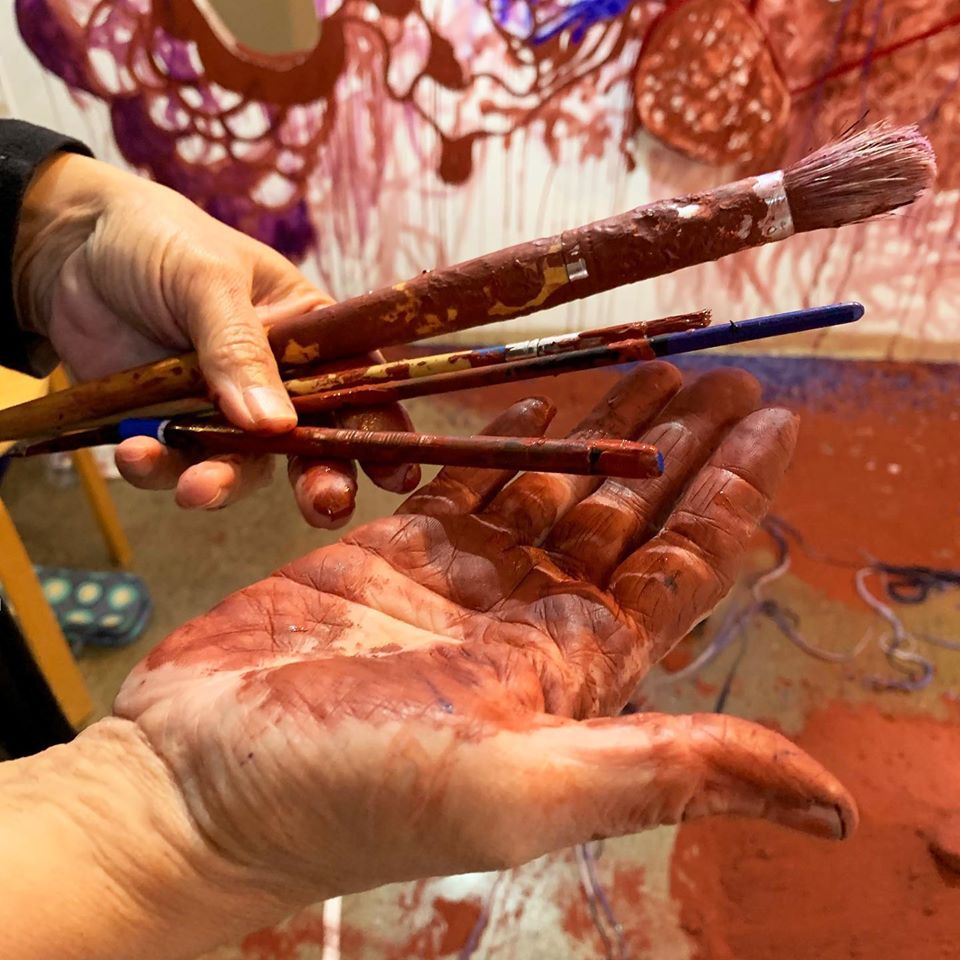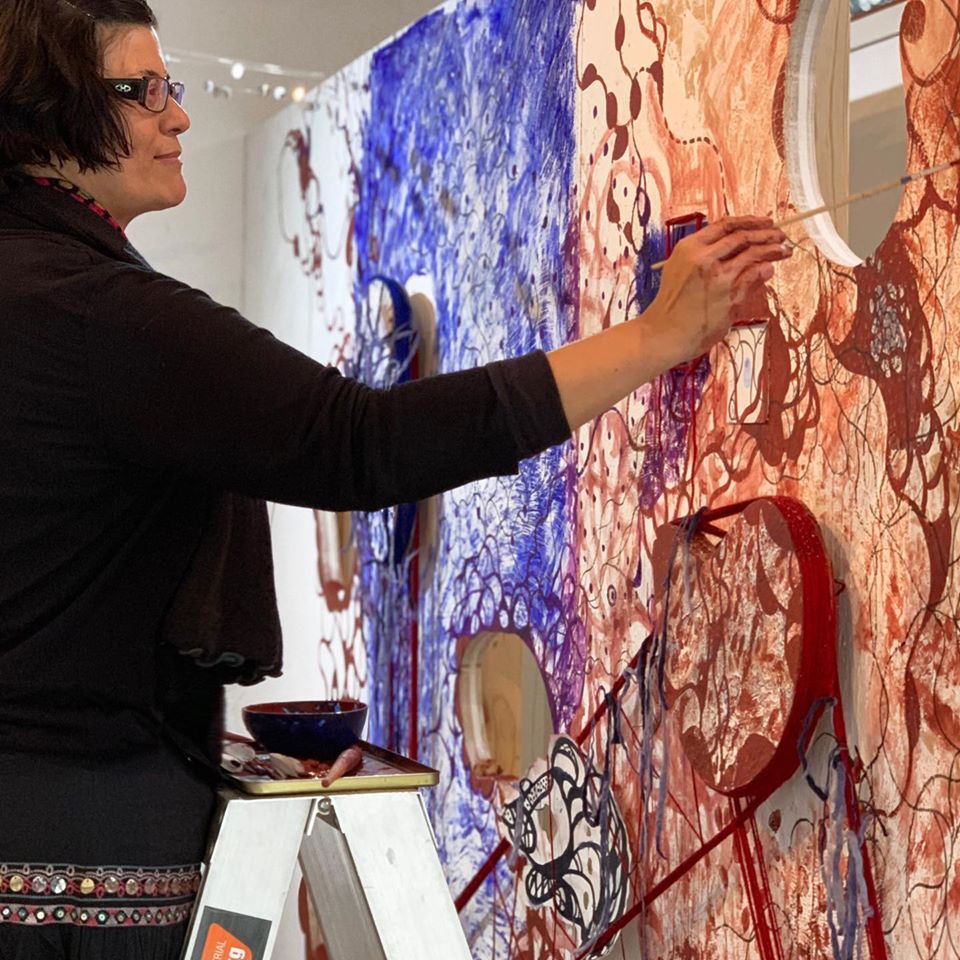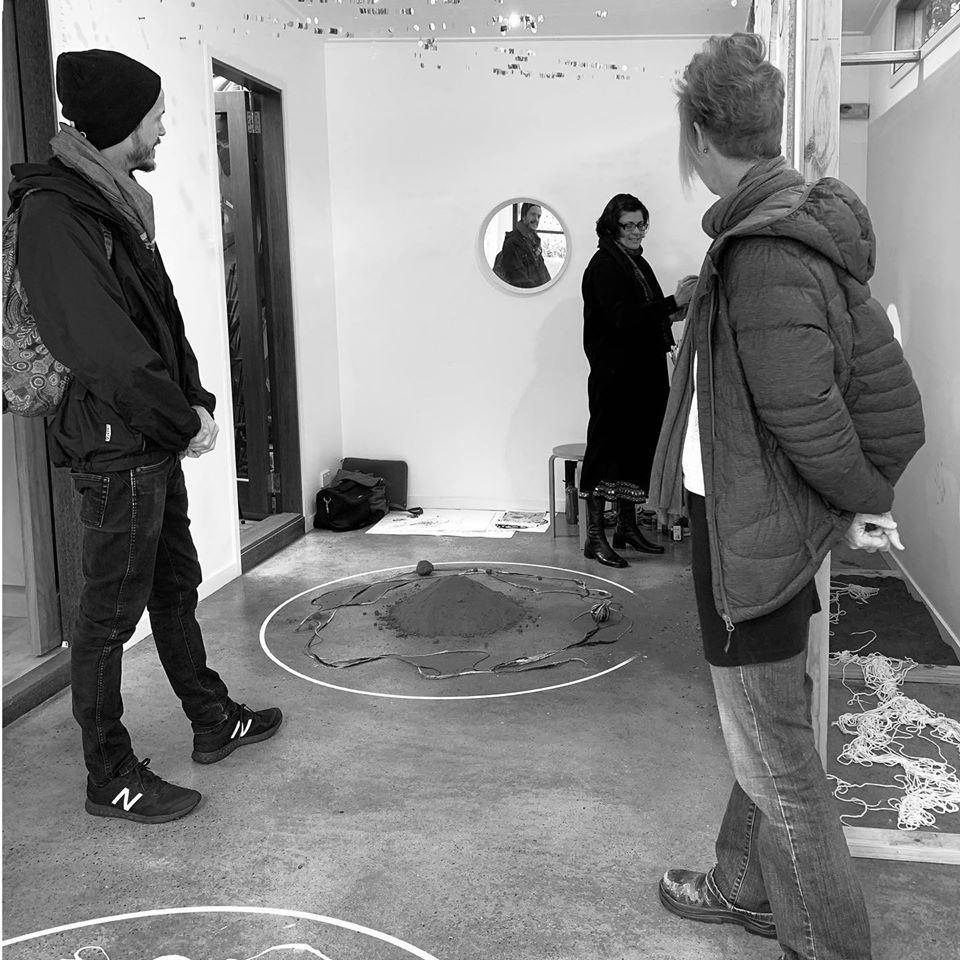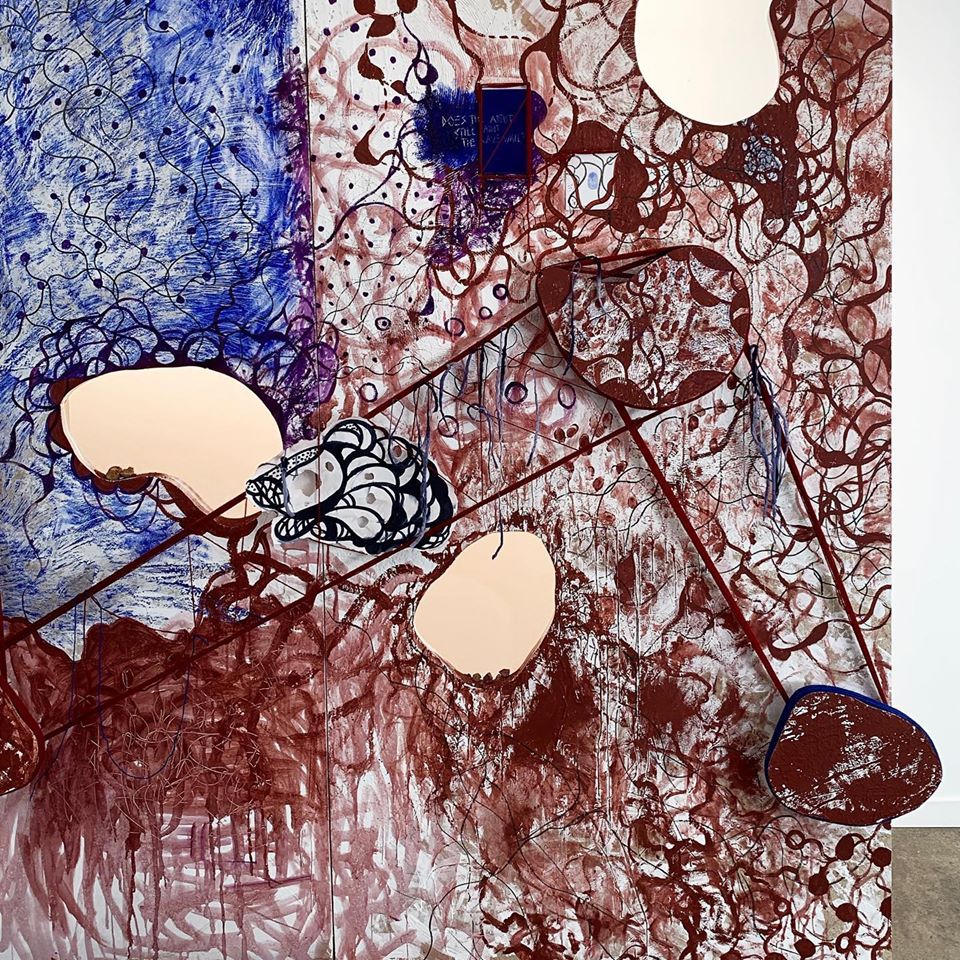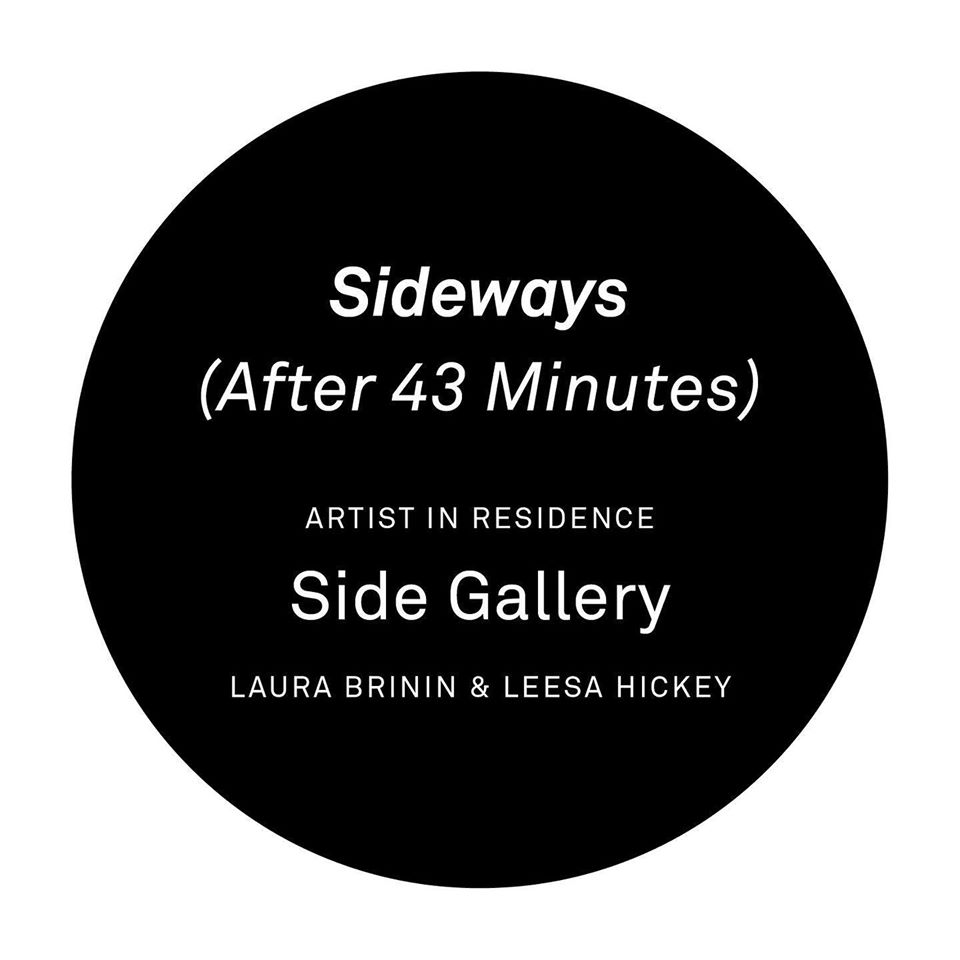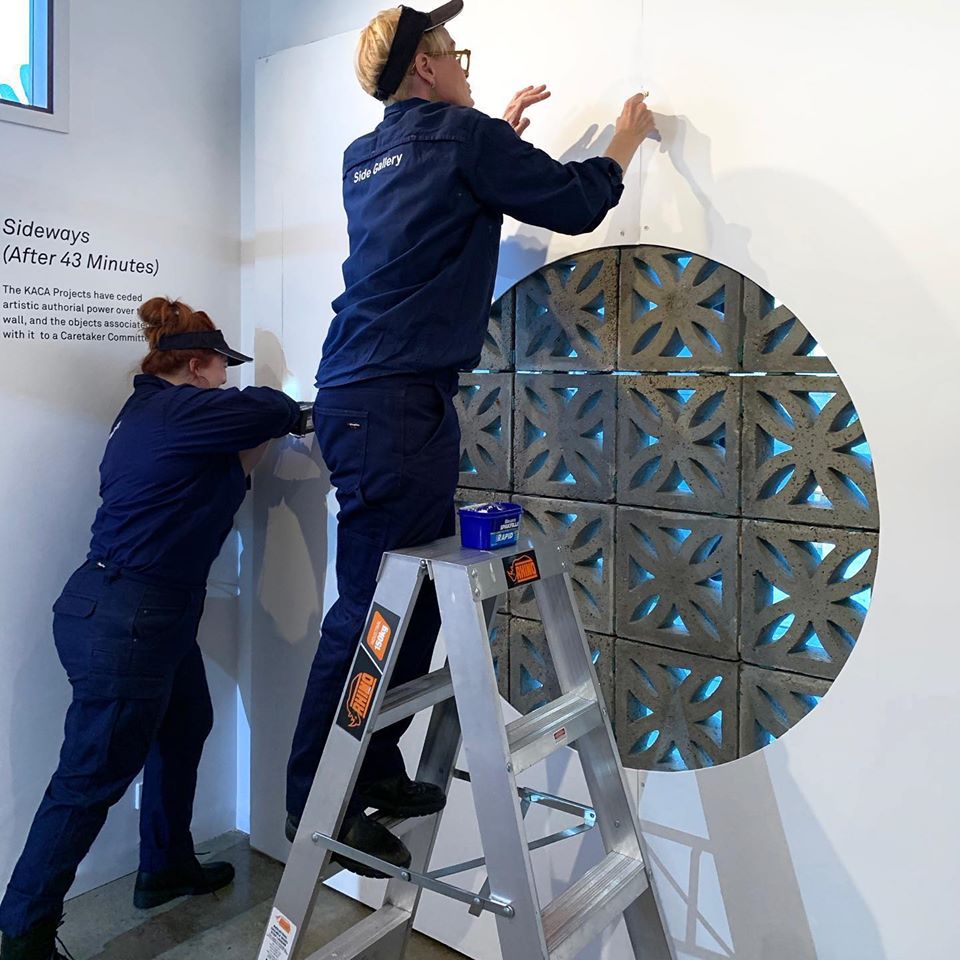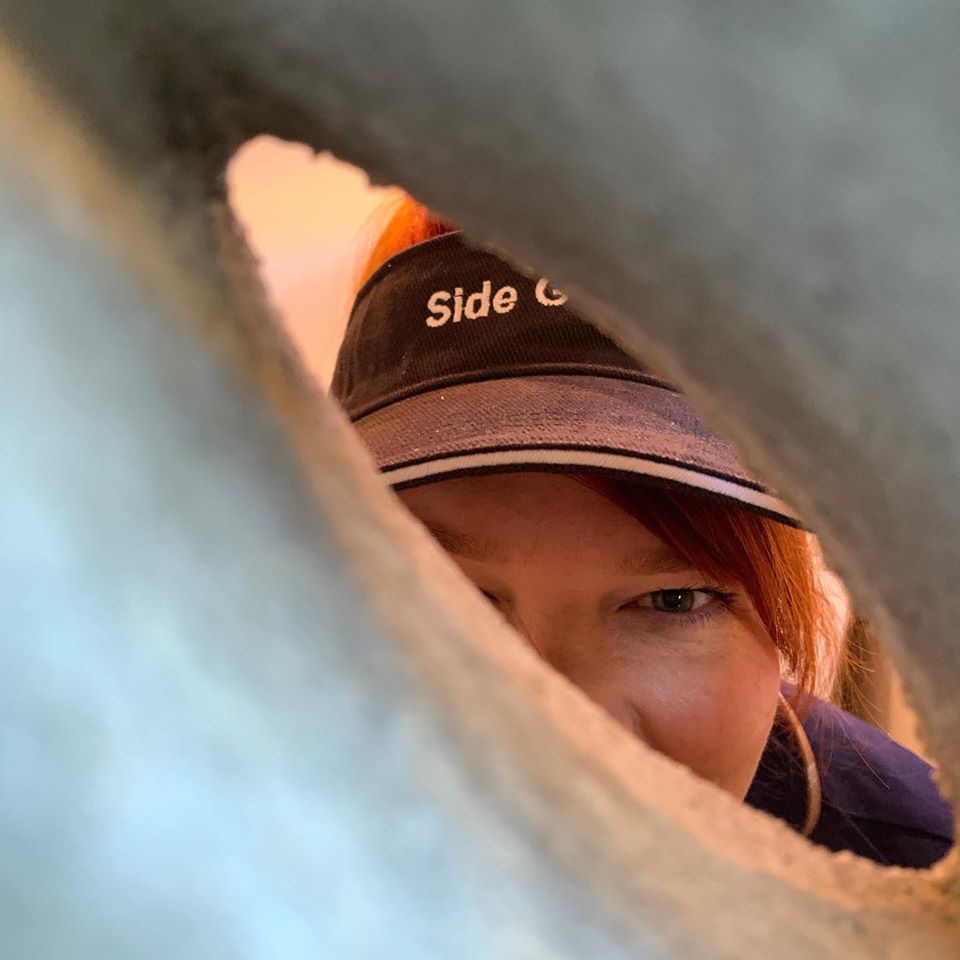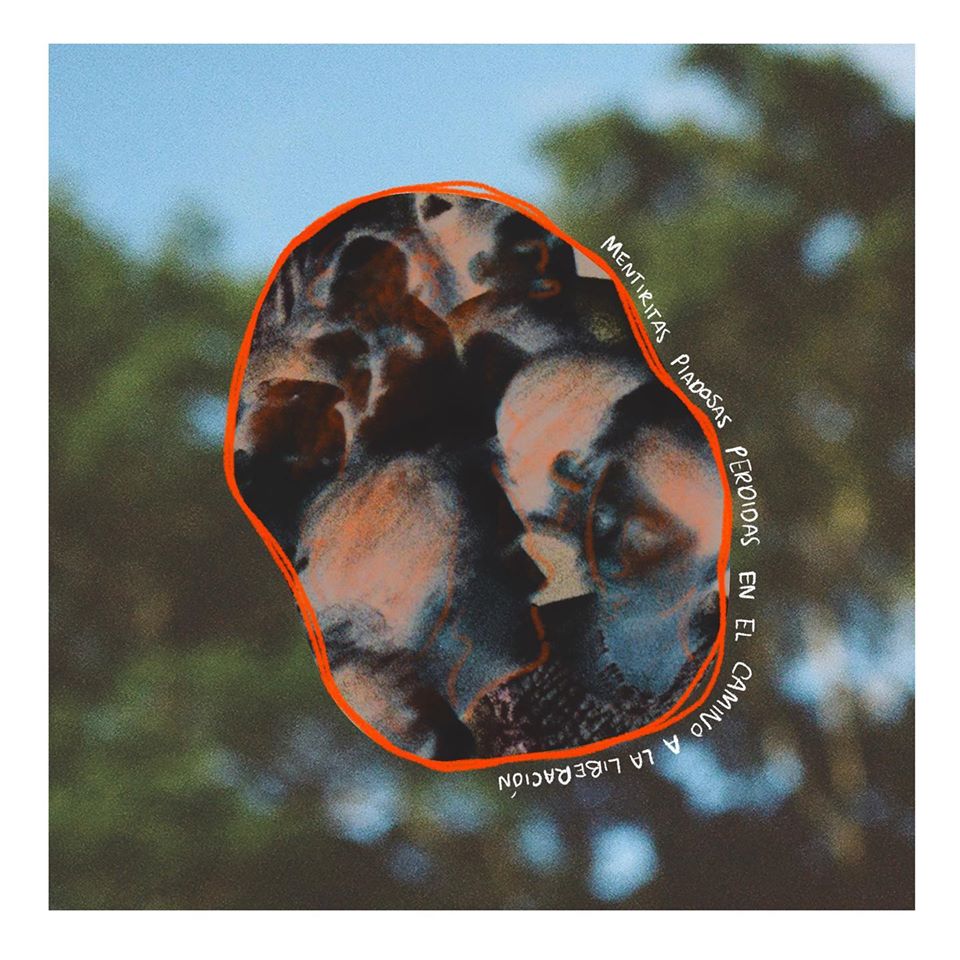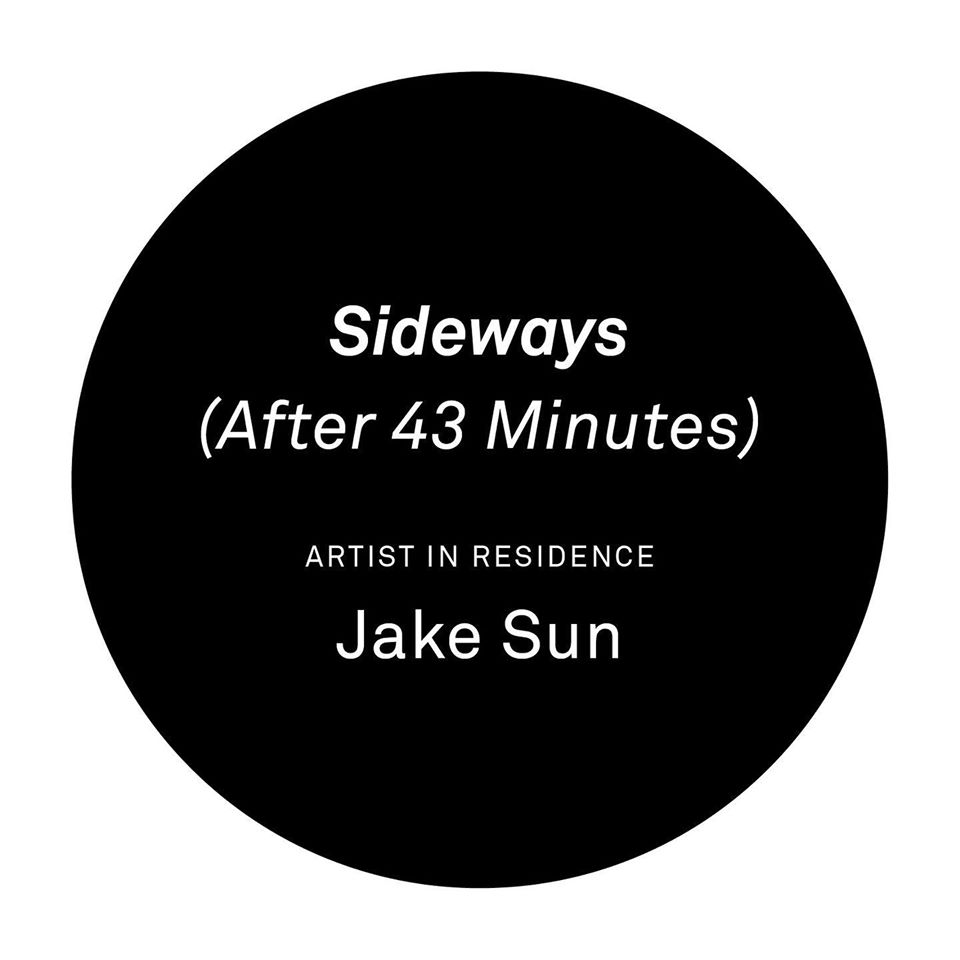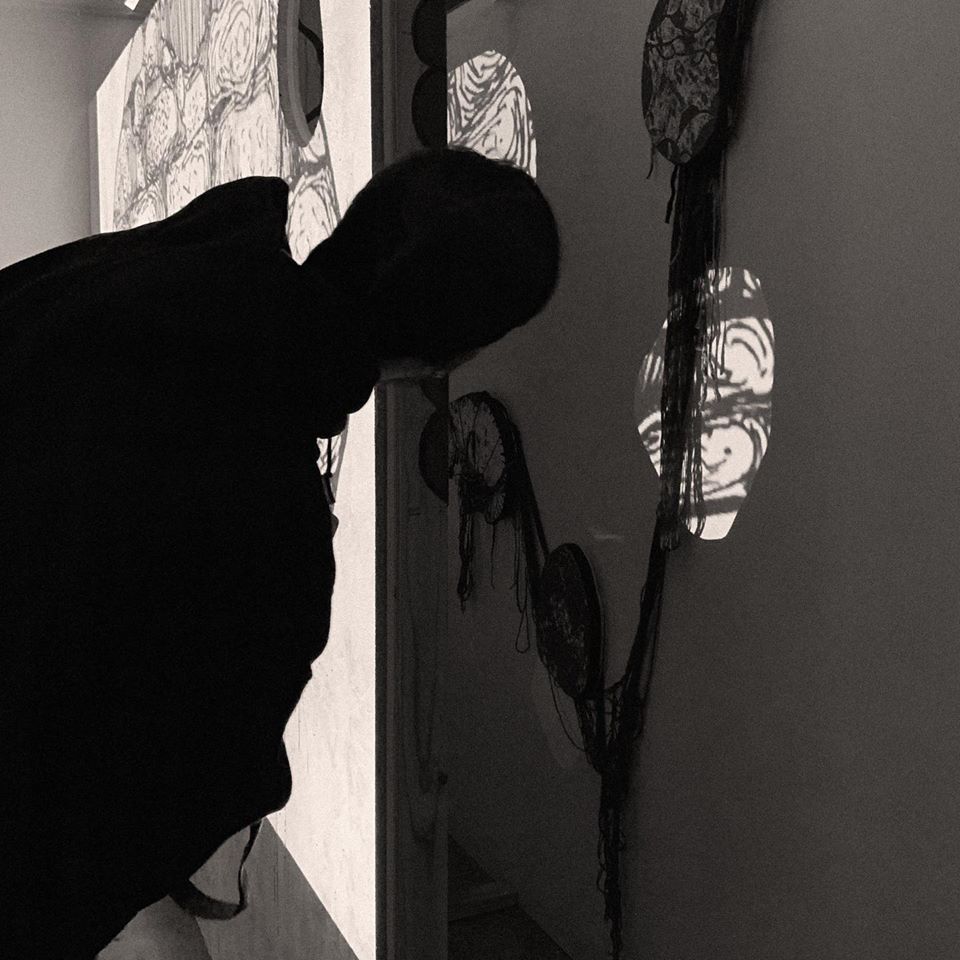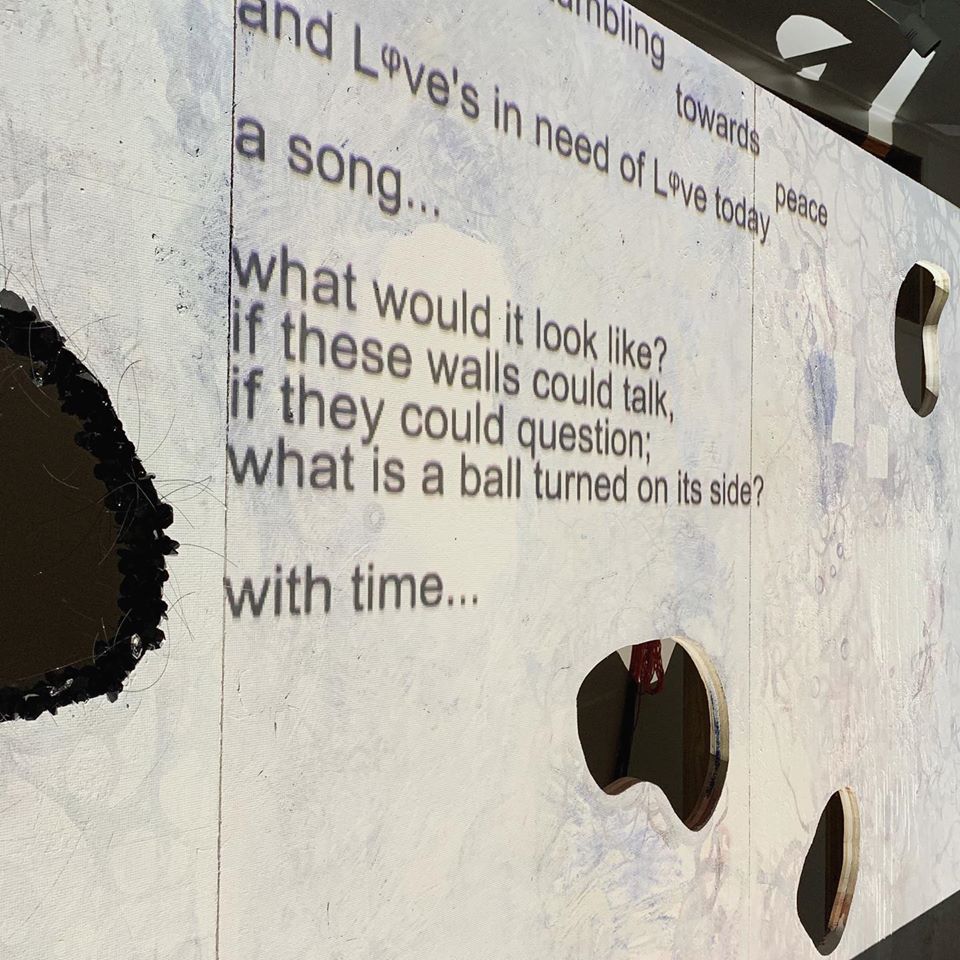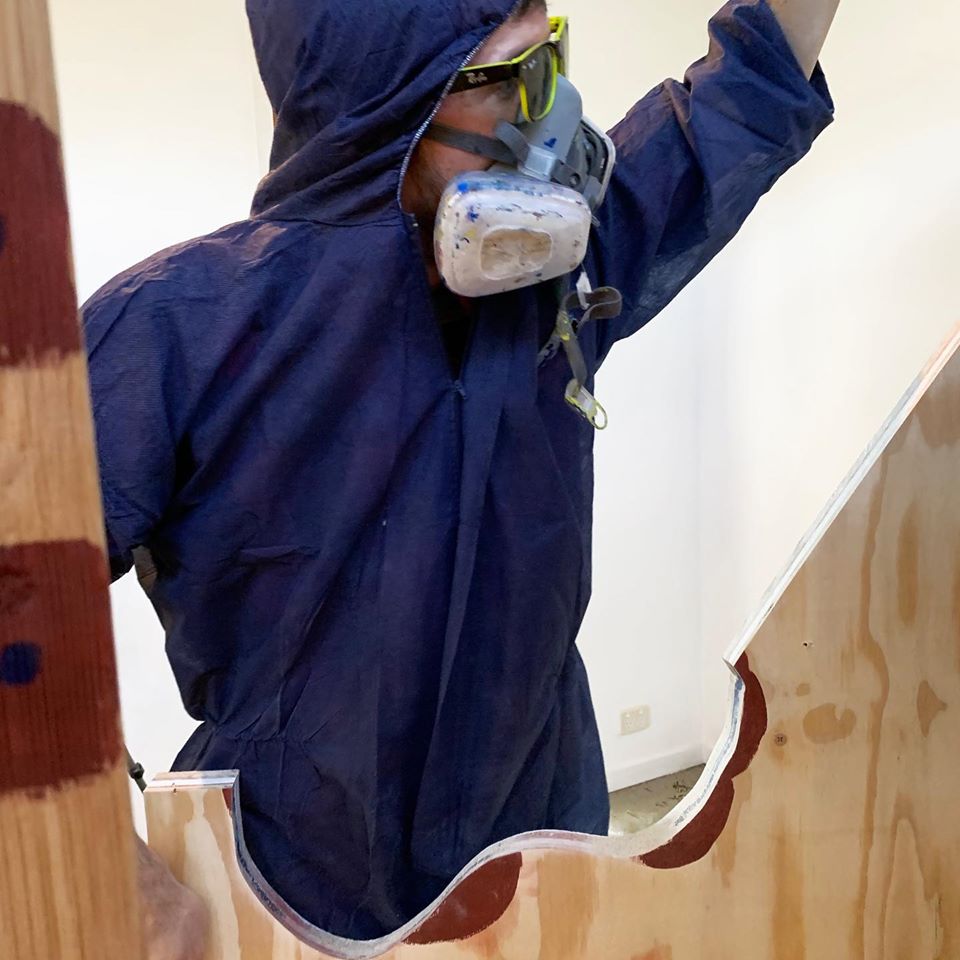March – July 2020
Sideways (After 43 Minutes) came about after the exhibition 43 Minutes as a result of COVID-19 social distancing measures in Queensland. Being in lock-down, we were unable to de-install 43 Minutes and we were essentially “stuck with the wall” inside Side Gallery, who were forced to postpone/cancel their exhibition program. In spite of the difficult circumstances of the pandemic, this gave us all time to slow down, think, explore and to innovate. It was wonderful and felt necessary.
By way of background…
For 43 Minutes we wanted to see if it was possible to explore and potentially oppose the major characteristics and effects of neoliberal capitalism through participatory art practice, such as:
- the metaphorical acceleration of time – under neoliberal capitalism, people are all so busy, busy getting things done/moving forward—i.e. neoliberal capitalism sees people (apparently willingly and instinctively) pursuing individual progress narratives. The pandemic has really showed us how trapped we are by ‘busyness’. [there are obviously exceptions to this].
- the overproduction of objects – under this system, needless commodities are produced, marketed, continuously desired for economic gain and status.
- the economic rationalisation of social life – for example, under neoliberal capitalism, our work lives largely determine our social relationships; nuclear families are economic units of production; people don’t (as a rule) connect with their neighbours or the environment, but rely on the instruments of capitalism (consumerism) to survive, etc. [there are obviously exceptions to this].
- the emphasis on the individual and the promotion of personal responsibility – neoliberal capitalism encourages individuals to ‘willingly’ think entrepreneurially and feel solely responsible for their decisions and actions. What this means is that the state, and other institutional power structures, get away with not having to be responsible. This devalues, and actively works to erode, collective action/activities—Marx’s ‘alienation of labour’.
- Can we re-evaluate the meaning and purpose of social and economic exchanges and produce a new kind of attention to the world and the people around us through (and in) art?
- Is it possible to cede power to participants in instructional art practice (for example, artistic authorial power)? And, what happens when we do?
We were interested in whether the act of ceding authorial power might see a way through neoliberalism’s emphasis on the individual (collaborative projects already do this to a degree we realise…). 43 Minutes developed (in part) in response to the John Baldessari instructional art piece at UQ titled Wall Painting. Wall Painting was the second staging of a conceptual project designed (but not implemented) by the conceptual artist John Baldessari. For Wall Painting, approximately 60 participants were invited to sign-up (in pairs), choose a paint colour and paint two layers of paint onto a gallery wall using paint rollers.
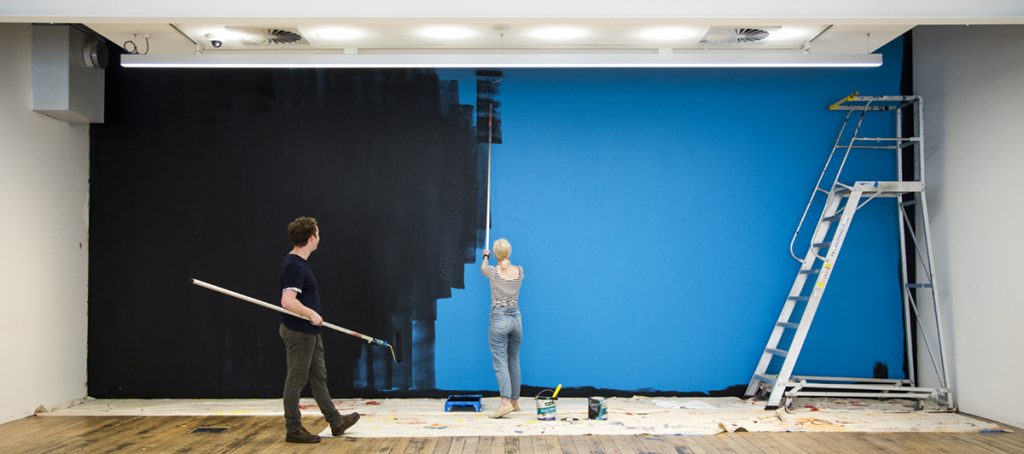
In the post-painting debrief discussion that followed, it was clear that the objective for Wall Painting was to encourage students to feel that they were part of the gallery/felt more ownership of the gallery space. What was interesting is that a permanent gallery wall was not used but a temporary wall was built for the project (which had the appearance of a ‘real’ gallery wall). When asked by one of the participants what was going to happen to ‘the wall’ afterwards, participants were told it was unfortunately going to have to come down as it was only a temporary wall. There was a timid yet fairly strong reaction from the participants that perhaps the gallery might consider keeping a piece of it. Participants seemed to want/need their collective contribution (recorded in the layers)—their trace—to be memorialised/valued somehow. The gallery seemed a little surprised by this but were open to this possibility.
To us, the curators of Wall Painting were genuine. The intention of their project was a desire to use the project (and the Baldessari name) as a way to give something back to the students/workers/painters/normally passive visitors to the gallery. That in the act of giving them decision-making ‘power’ in their choice of paint, and supposed ‘free-range’ to paint the temporary gallery wall, that this would give them some sort of control/power over the space/the project/the art (in their individual units of 2), for a short moment in time at least. Their expectations were for the project to create an ambivalent relationship around power in authoring art. It was our impression that they expected the project to be well received (which is was), but we felt that the gallery did not really consider (or appreciate) that under neoliberal capitalism ‘choice’ is a phantasy[1], or that the experience might produce a unique collective response from the participants, or moments of protest/intervention/expression outside of the instructions provided. This was interesting to us.
In addition, they did not (as far as we could tell) fully consider the institution in their curatorial premise about power i.e. who really has choice/power in the art system? Their interest seemed to be more about the democratisation of instructional art production. I.e. taking the work out of the hands of the artist (singular) and into the hands of students/ multiple (but individual) contributors—not in the democratisation of institutions of power in the context of the cultural centre/gallery, or the curator/director vs artist/worker power dynamic. Although institutional power is certainly implied in a work that explores democratising power in an institutional context, it did not seem to be of specific interest in the curatorial premise or the debrief discussions. This too was interesting to us.
Wall Painting was a thought-provoking project because it sparked dialogue and debate for The KACA Projects. The elements that felt dissatisfying about it for us is more about our interests rather than a direct criticism of the project, whose intentions were articulated in the curatorial premise. What we have perceived as ‘inadequacies’ or ‘oversights’ we set out to explore in 43 Minutes (and subsequently in Sideways): To explore the complexity of distributing power in the art system, and to try to unpack what we perceive as a trend (mostly) in large cultural centres: the commodification of ‘experience’ art. We utilised various strategies to explore this, such as: proposing an obscure (even absurd) objective for the wall painting task; being transparent about constructing a temporary wall (calling it a 5th wall); giving very little instruction to participants; providing unusual, useless or playful tools; exaggerating the commodification of experience etc. More–> here.
Then, given the opportunity in Sideways, we wanted to see if we could push this further, which was the purpose of the ceremonial hand-over of artistic authorial power, and in establishing an egalitarian Caretaker Committee to care for ‘the wall’ during its (and our) isolation.
The KACA Projects have ceded artistic authorial power over the wall, and the objects associated with it, to a Caretaker Committee.
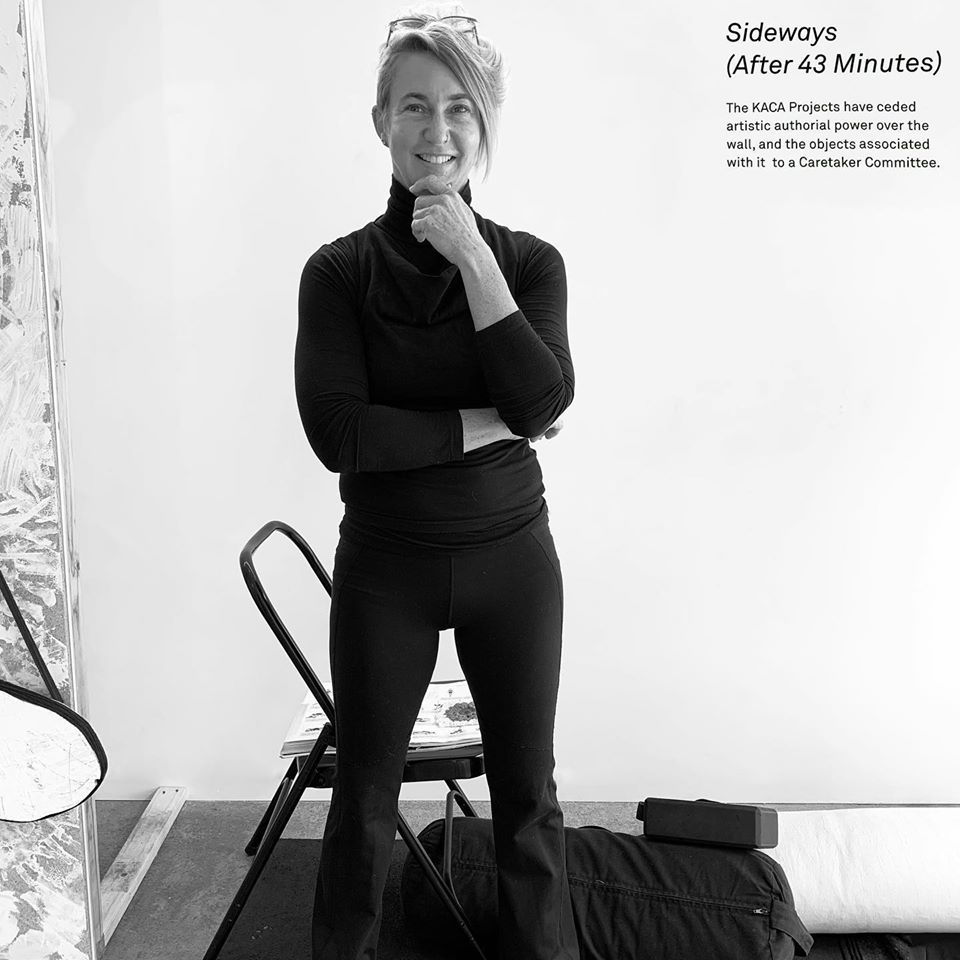
For Sideways, we were given the opportunity (through the circumstances of COVID) to think about the remnants of 43 Minutes (‘the wall’ and its ‘objects’) in terms of ‘attachment’—a sense of collective attachment that we needed in that particular moment when the world was shutting down. We realised that as the wall continued to stand in the gallery, a space for contemplation had opened up. A space (and an attachment) to collectively rethink and reshape our world towards new possibilities?
We were interested in the way the wall and its associated objects could be signifiers for this new space that had opened up.[2] A space we were thinking of like a ‘wedge’ or a ‘chasm’. A space where we might conceive a social and political order where profits are not above people—one that generates a new kind of intention to the world.
The Caretaker Committee consisted of five individual artists (plus Side Gallery who also participated; mischievously calling themselves The LeLa Projects). The artists involved had already participated in 43 Minutes and were invited to become Caretakers in Sideways. Only their title role of ‘Caretaker Committee’ was prescriptive; there were no other ‘rules and regulations’ prescribed. This act mimicked the ‘hands-off’, de-regulatory position of the state (and the corporations and institutions of power it serves), which in reality manifests as a combination of privatization, isolation and dispersion AND hyper-vigilant surveillance of the people (as the pandemic has clearly shown). In pressing the Caretakers to look inwards—towards ‘individualism’ one might say—we both anticipated individualism[3] but longed for resistance through collectivism. We were not disappointed.
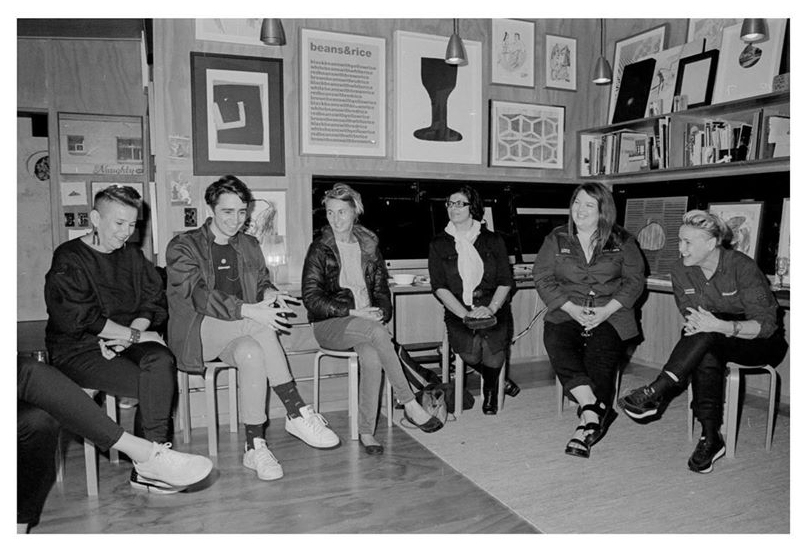
As we watched on silently over a couple of initial Zoom calls, the Caretaker Committee decided they would like to participate in an individual residency program to engage with/care for the wall over a 6 week period at Side Gallery. They allocated themselves a week each to use the space however they saw fit. Here are the results (pictured):
Caretaker Artists
Susan Lincoln, Daniel Sherington, Genine Larin, Natasha Narrain, The LeLa Projects, Jake Sun.
Participating Artists (artwork pictured)
Kate Barry, Carolina Navarrete, West End Art Gang member, Kirralee Robinson, Tamara Scheiwe.
Other participating artists (not pictured) Olivia Adlard, Paula Austin, Jordan Azcune, Jarrad Eve, Tallara Gray, Louise Isackson, Alia Josephine, Kagede, Carissa Karamarko, Sam Kariotis, Pia Larsen, Julie Paterson, Rossanne Pellegrino, Aaron Perkins, Jack Randell, Xinxin Wen, Adrienne Williams.
Outcomes of Sideways….
Sideways revealed an understanding of the group’s complicity in neoliberal capitalism and the futility of the project’s (perhaps) naïve intentions. As much as we might like to, it is impossible to stand completely outside of capitalism—this is the model to which we are all bound. For example, The LeLa Projects acknowledged their conflict over inviting artists to respond to the wall-shape cut-outs, and then feeling compelled (as the commercial enterprise, Side Gallery) to promote and sell these objects for their artists on the art market. This excellently demonstrates the impossibility of/problems with experimental art projects that attempt to resist capitalism whilst embedded in a capitalist framework. “It is capitalism achievement that it creates so many new needs not that it creates artificial needs” (Choat 2016).
It is at this point too, of course, that ownership becomes an ‘issue’. As Marx reminds us, because our system is driven by Capital, “the social connection between persons is transformed into a social relation between things”. And in collaborative projects such as Sideways—one where, in some cases at least, it has become literally impossible to discern who owns what—the ‘issue’ of ownership becomes nothing short of awkward. This awkwardness exists because capitalism demands an “alienated form of mutual interdependence” whereby we are slaves to an “estranged power materialized as money” (Choat 2016).
Within this frame, the irony of initiating a project—which was (in part at least) attempting to critique the overproduction of objects and the commodification of experience under capitalism—that then resulted in a literal explosion of all of these beautiful responses/objects to be promoted and sold—was super interesting but, on reflection, perhaps unsurprising. Particularly when we consider production and consumption under capitalism, as Marx does, as interrelated, “each creates the other in completing itself, and creates itself as the other.”
In spite of neoliberal capitalism’s relentless presence (and, we suppose, our collective impotency in refusing to not comply with it), what we have most valued about this project are the connections that have been made with one another through our profound attachment to, and nurturing of, the wall. We are all bound by this experience (and the record of this is forever memorialised in the wall, its fragments, and associated objects). Our collective attachment was further amplified when the project came to a close just as Queensland was beginning to emerge out of lock-down and return to ‘business as usual’—to the problematic ‘new normal’. Saying goodbye to the wall—our portal—at this time, felt horrendously difficult for us all. We reflected on this. Why did it feel so difficult?
We think it is because the collaborative response that unfolded in this project has felt extraordinary and intuitively subversive. Although The KACA Projects were initially disappointed that the residency approach the Caretakers decided on had such a strong individual/entrepreneurial flavour—which recalled neoliberalism so clearly—what the Caretaker group actually did (through successive creative responses that responded to one another) was participate in this beautiful, nurturing conversation through the wall. A conversation which (without overstating it) felt radical because it embodied a collective potency, and reminded us all of the sustaining value of care-work.[4]
In nurturing the wall, it has been all of our portal—our space to lament. It was built strong, with a robust body; it is the holder of many meanings; and has an agency beyond us and any system. As it continues to exist now in fragments, although we feel a sense of grief in it being dismantled (just as ‘the new normal’ is upon us), we are grateful for having had it with us for this time, and in this moment.
But, where to from here?
A special thank you to Side Gallery, the Caretaker Committee and all the participating artists for contributing to this unique experience.
Photos: Leesa Hickey, Delong Lin.
[1] As Davies and Bansel (2007) observe, “heightened individualism (which marks neoliberal systems) is registered in terms of individual freedoms, of autonomy and choice. Within this discursive framing the individualized subject of choice finds it difficult to imagine those choices as being shaped by anything other than his/her own naturalized desire or his/her own rational calculations.”
[2] For example, people were working from home; programs/work engagements were cancelled or postponed; people had more free time because they were not commuting; had less social engagements to attend to; there is more boredom generally. [obviously there are exceptions.]
[3] The global feminist Hakima Abbas’ commentary about the way Marx’ ‘alienation of labour’ has become a ‘coercion of labour’ under neoliberalism, is interesting to us here. Granted, when Abbas talks about this she is referring to sections of the community (particularly women) who find themselves “at the bottom of the supply chain” and forced to take “any employment at the expense of decent work”. Respectfully, we are taking liberties applying Abbas’ work on the precarity of women living in the global south to our privileged lives here in Brisbane, Australia. However, it is worth acknowledging the precarity of the artist’s life (even those who live in privileged contexts). It is interesting that the Caretaker artists responded very willingly to the opportunity to participate in a residency program at a reputable commercial gallery, even when they were not getting paid to do so. We understand from each artist that they found the opportunity to participate intriguing and therefore wanted to be involved. But in applying Abbas, we must also acknowledge that opportunities for art labour (even unpaid ones) are very few therefore, to what degree was their labour in both 43 Minutes and Sideways coercive? But perhaps it is very neoliberal of us to cast all artist bodies, lives and work in economic terms, or in terms of what they will get out of it—as homo economicus. I.e. economic payment, raising their profile, further opportunities to exhibit etc.
[4] The word radical is derived from the Latin radic meaning ‘root’. The root of things is our collective potency and the “life-making work of care” (Bhattacharya 2020). We already possess a collective capacity to change things from the bottom up—a capacity we have forgotten (or doubt) we have because it, along with our “radical imaginary”, has been so severely eroded by decades of neoliberalism (Ziadah 2020) and by a system that values “the production of dead things” (commodities) over people and the environment (Bhattacharya 2020).
